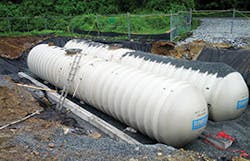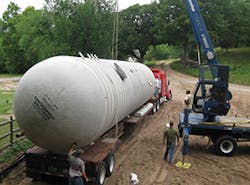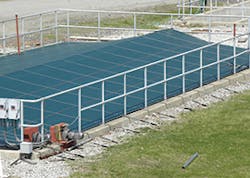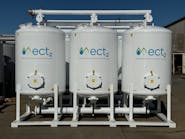Editor’s note: This article first appeared in the January/February 2014 issue of Water Efficiency.
Rob Pearlman, senior containment systems engineer with Plymouth, NH-based AmTech Tank Lining & Tank Repair, says that water tank problems rarely boast good timing. You can actually count on the opposite, he notes.
One moment a water tank will be quietly doing its job of holding water. The next? The basement floor of a hotel building has become a shallow lake.
The challenge? It’s nearly impossible to predict when a seemingly healthy water tank will suddenly go bad. Municipal and private users who don’t schedule regular inspections and maintenance on their water tanks, then, run the risk of suffering an unpleasant, and costly, surprise.
With today’s technology, most water tanks require little maintenance and are designed to last for decades.
“A tank without a problem won’t be a problem up until the exact moment when it develops a problem,” says Pearlman. “We run into that all the time. We always hear those famous words: ‘Gee, it’s never done that before until now.'”
This is why tank maintenance and repair is so important for municipal and private water users. No one wants a water tank to suddenly go bad. It’s far less expensive to maintain a water tank than it is to clean up the mess when one fails.
This is why it’s always worth it for municipal and private users to schedule regular inspections of their water tanks. It’s also why users should never put off even what seem like minor repairs to a tank that’s been damaged.
Editor's note: This article first appeared in the January/February 2014 issue of Water Efficiency. Rob Pearlman, senior containment systems engineer with Plymouth, NH-based AmTech Tank Lining & Tank Repair, says that water tank problems rarely boast good timing. You can actually count on the opposite, he notes. One moment a water tank will be quietly doing its job of holding water. The next? The basement floor of a hotel building has become a shallow lake. The challenge? It's nearly impossible to predict when a seemingly healthy water tank will suddenly go bad. Municipal and private users who don't schedule regular inspections and maintenance on their water tanks, then, run the risk of suffering an unpleasant, and costly, surprise. [caption id="attachment_1348" align="alignleft" width="270"]“The time to catch a problem is when the tank is denigrating but hasn’t failed yet,” says Pearlman. “When people call us, though, they’re past that point. They call us when a failure has been noted. And that usually means a more costly, involved repair.”
Fortunately, municipalities and private users can prevent most large-scale tank failures with just a bit of effort.
Carlisle Syntec’s GeoMembranes and GeoCovers protect fire ponds, irrigation canals, agriculture, and decorative ponds.
It doesn’t take much, after all, to schedule regular inspections of water tanks every three to five years. And as far as maintenance goes, there’s relatively little that municipal and private users have to do.
The heavy work of maintenance, in fact, might actually start at the very beginning, when private users and government officials are deciding which type of water tank to use at their facilities.
With today’s technology, most water tanks require little maintenance and are designed to last for decades, says David Heiman, director of marketing at Containment Solutions, a manufacturer of fiberglass storage tanks for water, petroleum, and chemicals. “The water tank industry has evolved over the years,” says Heiman. “The tanks we manufacture are non-corrosive. They won’t rust. They won’t deteriorate. That is one of our selling points, the largely maintenance-free aspect of our tanks.”
Which Tank Is Right?
Municipal and private users today can choose from three main types of tanks to store their water: fiberglass, steel, and concrete. Each of these tank types come with their own pluses and minuses. But they each have one thing in common: With periodic inspections, they can last for decades without suffering leaks or degradation.
The key, manufacturers of each tank type say, is for users to follow manufacturers’ recommended inspection schedules—which will vary by tank and tank type—and to hire professional inspectors who can spot a small problem before it grows too large.
Testing is important, too. There are several companies across the United States that offer tank testing services. These companies will look for leaks or structural problems in underground and aboveground water storage tanks.
Users should think of testing as uncovering current problems that must be addressed quickly. Inspections, though, can help uncover future problems. “Testing and inspections are important,” says Pearlman. “The testing will tell you how a tank is operating at the moment. An inspection will tell you where the tank is going, if there are problems that might become more serious in the future. Both are important. You don’t want to be surprised by a tank problem if you can help it.”
Rich Horn, regional sales manager with the Plainfield, IL, office of CB&I, a manufacturer of steel water-storage tanks, says that with the technology used today in water tanks, municipal and private users need only schedule inspections every three to five years in most cases.
Users are exploring fiberglass tanks today as a viable option to store their water.
Horn, who is also chairman of the Steel Tank Institute/Steel Plate Fabricators Association’s Field Erected Storage Tank Section, says that this holds true for tanks of all types. “It’s really simple stuff to maintain these tanks,” says Horn. “You need to hire someone who has experience inspecting water tanks, someone who knows how to climb tanks and what to look for. This person will then write a report. It’s up to the city or private user to act on the recommendations made by an inspector or consultant. If they do, they’ll generally avoid any surprises or sudden failures.”
How durable and long-lasting are water tanks when properly maintained? Consider that the Steel Tank Institute regularly honors steel water tanks and piping that have remained in service for 100 years or more. That’s the definition of durable, and the institute currently boasts 24 water structures across the country in its Century Club.
It’s little surprise that Horn has long been a believer in the strength of steel tanks. He points to video he has of a Class-5 tornado in Oklahoma. In this video, the tornado tears through a town and roars over an elevated steel water tank. But, instead of ripping the tank to pieces, the fierce winds barely cause it to shudder.
Users are exploring fiberglass tanks today as a viable option to store their water.
“The steel tank was still there. And these were some of the fastest winds you can imagine,” says Horn. “There was so much damage everywhere. But that tank was still standing there. It looked like it hadn’t been touched at all. It was a pretty amazing thing to see.”
And with the effectiveness of today’s linings and coatings in keeping water away from the actual steel used to construct these tanks, rust and corrosion have become less common problems among steel tanks, says Horn.
Of course, the manufacturers of concrete and fiberglass water tanks also have plenty of positive things to say about their tanks. They, too, are resistant to the elements, they say. And, they’re not susceptible to rust.
Tom Tietjen, vice president of sales and marketing with Minneapolis, MN-based Xerxes Corporation, a manufacturer of fiberglass tanks, says that users are exploring fiberglass tanks today as one more option to store their water. “In terms of the industry, fiberglass is a relatively new material for water storage,” says Tietjen. “You go back centuries and see water tanks made out of concrete and steel.
Fiberglass is relatively new to the industry. But, fiberglass as a material is becoming increasingly recognized and specified in a wide variety of water applications. “That’s certainly the case with potable water,” he continues. “As the product becomes more familiar to engineers and owners, I think you’ll see even more municipalities choosing fiberglass.”
Heiman says that a growing number of users—both in the municipal and private arenas—are exploring the benefits of fiberglass tanks. And Heiman, like Tietjen, says that demand for these tanks will only continue as users get more familiar, and comfortable, with fiberglass. “Demand is absolutely on the rise for these tanks,” says Heiman. “There are no rusting or corroding worries with these tanks. We are seeing more jobs where fiberglass is being specified. It’s certainly a growing part of the industry.”
“A lot of times, it’s just buying habits and an awareness issue,” says Tietjen. “Many municipalities turn to engineering firms to design their facilities and spec out their equipment. They often times don’t do that internally with their own city staffers. So, our challenge for years now has been to educate the engineering community, the private engineering firms who have municipalities as clients, about the features and benefits of fiberglass.”
Why Maintenance Matters
This doesn’t mean that today’s tanks are invulnerable. They can still be damaged, and each tank type has its possible weaknesses if not maintained properly, whether it’s surface damage from exposure to UV rays or the threat of rust.
Horn has proof of this in the form of a photo of a degraded water tank in which a sturdy sapling is now growing out of a crack. CB&I has since replaced the degraded tank with one of its own. But the fact that the tank was damaged enough to provide life to a young tree is proof that without proper maintenance and repair, even relatively sturdy water tanks can fail.
It’s important for municipal officials and private users to take the steps necessary to head off these potential problems—with regular inspections and testing—and to repair any damages before they grow into more catastrophic and expensive problems.
Pearlman says that serious problems can start from something as small as a screwdriver hitting the bottom of a tank when the device is being built. This, he says, can easily scratch the coating that prevents a tank from corroding. And then, over time and through continued exposure to water, that tank can begin to rust.
“Sometimes you don’t notice what has happened,” says Pearlman. “You have to examine the tank regularly and give it an integrity inspection. Once whatever the tank is storing—water or chemicals—goes past the corrosion coat and into the body of the tank, problems can happen. The body of the tank is not made to be impermeable. It’s just made to be structurally sound.”
Capillary action—in which liquids can flow through narrow spaces even in opposition to gravity—can then take over. The product stored in a tank—again, usually water or chemicals for municipal users—can then migrate through the body of the storage unit.
It might take municipal officials years to discover this key flaw in their tanks. They might only discover it, in fact, once they notice water or chemicals leaking on the outside of the pipes connected to the water tank.
“People think leaks happen in the bottom of their tanks,” says Pearlman. “But that’s not always the case. Often, fluids will go around the body of the tank. They take the path of least resistance.”
Fiberglass tanks, too, come with their own challenges, Pearlman says. These tanks are not meant to sit outside in sunlight without the protective coatings that protect them from the impact of UV rays.
“We get three calls a week sometimes from people saying that their tank’s exterior resin is disappearing or degrading,” says Pearlman. “That can cause serious damage over time, too.”
For Tietjen, education is the key. It’s why he and his fellow staffers at Xerxes spend time talking to their clients about maintenance and regular inspections and why both play such important roles in extending the life of a water tank.
Many municipal and private users make the mistake of paying to have their water tanks installed and then forgetting about them until a problem suddenly hits, Tietjen says.
Heiman agrees, and also spends time educating his clients on how to properly take care of their water tanks. Again, the main key is for users to order professional inspections of their tanks according to the specific instructions of their manufacturers.
“It’s easy to put it off,” says Heiman. “But doing so can increase the chances that your tank will suffer some sort of undetected damage.”
Because municipalities are often pumping potable water directly from reservoirs to customers, they need barriers to protect against airborne contaminants.
Lining, Covers
Of course, municipalities and private companies don’t just store their water in tanks. Many private companies and municipalities store water in ponds or reservoirs. Municipalities might use a pond, for instance, to hold water that it will then use for fire-prevention efforts. Others maintain irrigation canals.
Private users such as corporations or other businesses might boast decorative ponds on their campuses, while others might feature large retention ponds.
Users can choose from several different types of covers to protect the water they are storing in their ponds and reservoirs. Carlisle, a manufacturer of covers based in Carlisle, PA, offers reinforced polypropylene geomembrane sheets that act as liners and floating coves, covers that work best in buried or exposed geomembrane applications. Users might also choose Carlisle’s non-reinforced polypropylene geomembrane sheets. These are designed for applications in which elongation is a must. These sheets boast an elongation factor of more than 300%.
Burke Environmental Products, based in San Jose, CA, offers its own line of geomembrane liners and covers approved for potable water applications. Municipal and private users have not been shy about investing in these covers. Burke Environmental says that more than 200 million square feet of the company’s geomembrane liners are now installed in a variety of applications. This includes everything from liners for decorative ponds to floating covers for potable water and methane gas collection systems, according to the company.
Stephen Roades, a vice president with Burke, says that municipalities turn to floating covers for two big reasons: They want to prevent airborne contaminants from getting into their water supplies and they want to reduce the amount of water they lose to evaporation.
This second reason is actually becoming more important, Roades says. Water is a valuable resource, one that municipalities can’t afford to lose to evaporation. Municipal budgets are tight today, and water is a revenue source for many municipalities. These cities and towns, then, don’t want to watch their profits evaporate.
“Water is expensive,” says Roades. “In large, open-top reservoirs, municipalities can lose an awful lot of water to evaporation. That is water that they are not providing to their constituents and water that their constituents are not paying for. By covering these reservoirs, municipalities can eliminate their evaporation or cut into it substantially.”
And because municipalities are often pumping their potable water directly from their reservoirs to their constituents, they’re also often searching for barriers that can keep airborne contaminants away. Geomembrane covers can serve as such a barrier, Roades says.
The good news? These covers are more economical than brick-and-mortar covers. “Brick-and-mortar covers get to be astronomically expensive,” says Roades. “Many municipalities just don’t have the budget for something like that.”
Geomembrane covers have caught on for potable water reservoirs in much of the country, including the East and West Coasts. But, Roades says that his company has struggled to sell these covers to companies and municipalities in the middle portion of the country.
And that’s something that puzzles Roades. “I don’t have an answer for why that is; I really don’t. Maybe they don’t get airborne contaminants in Chicago. Maybe the water doesn’t evaporate as fast there,” jokes Roades. “We have installed geomembrane covers all across the country. We just don’t see much demand for them from the middle part of the country.”
Covers also mean less water vanishing into thin air.
Aging Infrastructure
There’s more to a municipality’s water-storage system than tanks, reservoirs, and ponds. And that’s an important factor for municipal officials to remember as they draft maintenance and repair schedules.
The unfortunate truth is that far too many municipal water systems are cursed with aging infrastructures. Pipes and pumps are steadily deteriorating across the country. Water tanks that aren’t rusted or corroded are nice to have. But if the pipes that feed these tanks are pockmarked with leaks, a municipality’s water system isn’t going to operate efficiently, and the water loss from the system can still prove costly.
Heiman says that this is an issue that municipalities need to face, sooner rather than later. “Municipal water rates are rising, and they are often rising faster than inflation,” he says. “They are taking up a larger part of household budgets across the country. That’s because so many municipalities face expensive repairs. Most systems are decades old. Many of them are in disrepair. Others are struggling to stay compliant with federal regulations. Repairing and maintaining these systems is expensive.”
Many municipalities are offering financial incentives—credits or water bill discounts—to encourage their users to consume less water and conserve more. This makes sense: If consumers waste less water, it places less stress on a municipal drinking water system.
But while the benefits of such incentive programs are real, they won’t do much to help those municipalities whose water infrastructure is already in serious decline, Heiman says. “Municipal water is income,” he says. “Municipalities charge for it. Having some residential help—help from the residential consumers in conserving water—will be a benefit. But it won’t provide the big solutions. An aging infrastructure is a very real issue for many, many municipalities.”
Tietjen from Xerxes agrees, though he adds a caveat: while it’s true that aging infrastructure is a problem that impacts all types of water systems, it’s a particularly troubling challenge for wastewater systems, he says.
The reason? Wastewater systems face more corrosive conditions than do potable systems.
“A city or county facility that owns a combination of wastewater and potable water infrastructure would probably have greater concerns from an aging point of view and when it comes to equipment replacement from the wastewater side of it. That side just deals with more corrosive materials.”
That being says, aging infrastructure is not something that municipal officials working on the potable end of the water delivery business can afford to ignore, either, Tietjen says. “This is definitely an issue that the entire country faces,” he says. “Municipalities and private industry, but municipalities, in particular, are going to have to find some way to pay for repairing their water system infrastructure. How do they budget for replacement?”
Unfortunately, there aren’t many answers. Municipalities across the country are still dealing with budget shortfalls and cutbacks. And these budget pressures don’t figure to ease any time soon.
Water rates, as Heiman says, are already on the rise. They might have to jump even higher if municipalities are to successfully maintain and repair their aging water systems.
In good news, tanks are rarely the biggest problem spots when it comes to aging infrastructure, Tietjen says. If properly maintained, he says, his company’s fiberglass tanks can long outlast their warranties, and may even have a longer lifespan that the water-distribution system they are serving.
“There are no telltale signs of damage for owners to look for in five to 10 years,” says Tietjen. “There just aren’t any. Fiberglass tanks are designed to have a very long lifespan. Some people think the lifespan is the same as the warranty. It’s not. In many cases, the tank will outlive the water distribution facility.”










